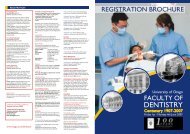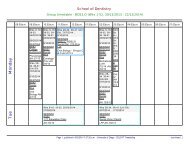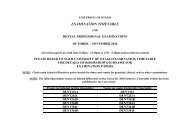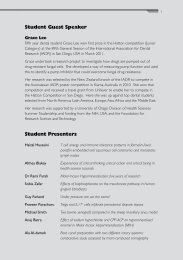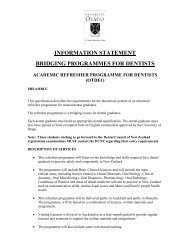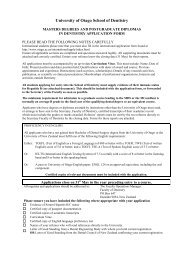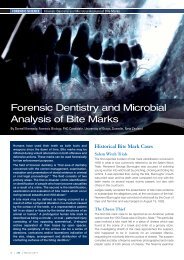2OO9 – 2O1O - Faculty of Dentistry - University of Otago
2OO9 – 2O1O - Faculty of Dentistry - University of Otago
2OO9 – 2O1O - Faculty of Dentistry - University of Otago
Create successful ePaper yourself
Turn your PDF publications into a flip-book with our unique Google optimized e-Paper software.
Sir John Patrick Walsh KBE<br />
MUCH GAIN AND MINIMISED PAIN<br />
Sir John Walsh made such a remarkable contribution to dentistry in New Zealand<br />
that Chapter 8 <strong>of</strong> Tom Brooking’s “A History <strong>of</strong> <strong>Dentistry</strong> in New Zealand” is entitled<br />
the “Walsh Era 1947-1972.” After graduating with a first class honours degree in<br />
dentistry (followed by a medical degree), and then serving as a medical <strong>of</strong>ficer in the<br />
Royal Australian Air Force, this self-described “brash Australian” was appointed as<br />
the 3rd Dean <strong>of</strong> the School <strong>of</strong> <strong>Dentistry</strong> at the <strong>University</strong> <strong>of</strong> <strong>Otago</strong> in 1946. Walsh’s<br />
appointment advanced dentistry at many levels. He served as a spokesperson for<br />
dentistry at the World Health Organisation, led a campaign that overcame vociferous<br />
opposition to fluoridate water supplies in New Zealand cities, and succeeded after<br />
10 years <strong>of</strong> struggle with reluctant university authorities (and even more reluctant<br />
government) to build the iconic glass curtain building that now houses the <strong>Faculty</strong> <strong>of</strong><br />
<strong>Dentistry</strong> and bears his name. Under his leadership, the <strong>Faculty</strong> <strong>of</strong> <strong>Dentistry</strong> obtained<br />
the highest international standards by broadening its clinical and scientific base and<br />
reaching out to the dental pr<strong>of</strong>ession and the community. Walsh edited the New<br />
Zealand Dental Journal for several years and had a reputation for being extremely<br />
scathing about dental practices that equipped too many New Zealand adults with<br />
“false teeth faces” in the mid-20th century. Walsh was a powerful advocate <strong>of</strong> research.<br />
Staff members in the <strong>Faculty</strong> <strong>of</strong> <strong>Dentistry</strong> were encouraged to undertake PhD study,<br />
and the School <strong>of</strong> <strong>Dentistry</strong> set out to “grow” its own researchers by introducing the<br />
highly successful MDS graduate programme. This focus on research was achieved with<br />
the support <strong>of</strong> Walsh’s ally, Sir Charles Hercus in the Medical School (also a dental<br />
graduate). After more than 50 years, the MDS degree has been replaced by the<br />
Doctorate in Clinical <strong>Dentistry</strong> (DClinDent). Most importantly, this change will increase<br />
the research experience and clinical expertise <strong>of</strong> graduates in a world where biological<br />
knowledge and its impact on clinical practice are changing at an unprecedented rate.<br />
This initiative to improve and more fully inform dental practice through research would<br />
undoubtedly have been endorsed by Walsh.<br />
Sir John Walsh’s contribution to the development <strong>of</strong> the modern high-speed dental<br />
handpiece was one <strong>of</strong> his most significant but least well-known achievements. Electric<br />
drills introduced near the beginning <strong>of</strong> the First World War were inefficient and, by<br />
operating at only about 3000 rpm, caused considerable discomfort to patients. While<br />
testing the hearing <strong>of</strong> Australian airmen discharged from service at the end <strong>of</strong> World<br />
War II, Walsh not only identified frequencies that caused pain but also those that did<br />
not. This led to the hypothesis that the vibrational frequencies imparted by dental<br />
drills rotating at sufficiently high speeds would minimise patient discomfort. With<br />
the assistance <strong>of</strong> H.F. Simmons from the <strong>University</strong> <strong>of</strong> <strong>Otago</strong> Department <strong>of</strong> Physics,<br />
an existing air-powered low-speed drill was modified to operate initially above the<br />
42,000 rpm vibrational threshold and then at 60,000 rpm. In 1947, Walsh persuaded<br />
the Ministry <strong>of</strong> Science and Industry to underwrite the development <strong>of</strong> the air turbine<br />
handpiece at the Dominion Physics Laboratory in Lower Hutt. By 1949, a prototype<br />
was made available to Walsh, who then obtained the results that contributed to his<br />
DDSc from the <strong>University</strong> <strong>of</strong> Melbourne and to the issue <strong>of</strong> a New Zealand patent.<br />
Although the prototype overcame the pain problem and required minimal operator<br />
force to work efficiently, its high-pitched noise, excessive exhaust <strong>of</strong> air into the patient’s<br />
mouth, and the too-frequent seizure <strong>of</strong> its primitive bearings (due to overheating)<br />
made it difficult to obtain further support from government or commercial sources.<br />
In 1952, Walsh’s research on the air turbine handpiece ceased due to lack <strong>of</strong> funding.<br />
American and Swedish research had overcome the technical problems by about 1955<br />
and, in 1957, the Borden Airotor was marketed by the Dentists’ Supply Company. R.J.<br />
4 FACULTY OF DENTISTRY RESEARCH REPORT 2009-2010



